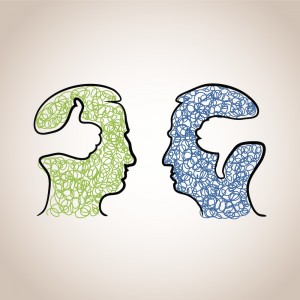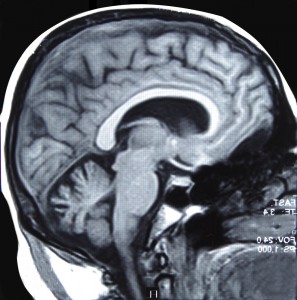
For over 30 years researchers have found that people with a diagnosis of schizophrenia have, on average, differences on brain scans compared to people without. Not everybody with a diagnosis of schizophrenia will have these differences and it has not yet been possible to use brain scanning as a test to work out whether someone has schizophrenia or not.
People who are experiencing psychotic symptoms for the first time, and have never had any treatment, do have changes on brain scans but many other factors can impact on studies in schizophrenia:
- different symptoms
- differences in severity of the symptoms
- different life experiences (both before and after having a diagnosis)
- the stage of the illness
- different treatments
- use of other substances
This has made teasing out what may be influencing the brain imaging findings very difficult, especially when individual studies have not involved enough participants to be able to fully explore all the complex influences involved.

A change in brain structure can be positive, negative or neutral
The effect of antipsychotic medication on changing gross brain structure has been controversial. Antipsychotics do help most people with schizophrenia cope with their symptoms (see these Mental Elf blogs from May 2012 and Aug 2013) and a substance that has to affect the brain’s biochemistry in order to work will, as an essential part of its action, change the structure and function of the brain.
If modern scanning techniques are now able to detect these changes it does not really alter the rationale for using antipsychotics: helping people cope with the distress of the symptoms. On the other hand if there are specific patterns of brain changes, then this might flag up concerns about side effects that were not known about before. A change in brain structure can be positive, negative or neutral.
Methods
To try and answer whether antipsychotics are linked to progressive brain changes a large number of people need to be compared. Researchers with a lot of experience doing meta-analyses of brain scanning studies did an extensive search of the literature to find studies that had scanned the same people on at least two occasions (average 72 weeks apart). They focused on studies that had included information about antipsychotic treatment, illness duration and illness severity.
The researchers had big problems with different studies reporting their results in different ways and only a few could be compared in the final analyses. This was despite them restricting their study to only looking at the whole brain and not smaller subdivisions of the brain.
From 116 studies initially found only 30 made it into the study, and then only 8 made it into the analysis looking at antipsychotic treatment.
Antipsychotic treatment was measured by the total exposure to the drug over the course of the individual trial.
Results
- At baseline people with schizophrenia, on average, had a reduction in the size of the whole brain when compared to controls (p=0.002)
- And larger lateral ventricles (p<0.001)

People with schizophrenia taking antipsychotics saw a significant reduction in grey matter compared to controls
- Over time there was a reduction in the size of the whole brain of both patient and controls, but this was not significant in either group
- In patients, but not controls:
- Grey matter decreased (p=0.002)
- Lateral ventricles increased in size (p=0.002)
- But white matter and cerebrospinal fluid did not change significantly
- In patients, but not controls:
- The effect of potential moderators was:
- Greater cumulative antipsychotic exposure was associated with a greater reduction in the grey matter volume in the brain (689 patients, standardised mean difference = 0.013, C.I. 95% from -0.033 to -0.001, p=0.048)
- Lateral ventricle size was not associated with antipsychotic treatment
- They did not find enough data to look at the actual level of symptoms but changes in symptoms were not associated with significant changes in brain size
- Duration of illness was not associated with significant changes in brain size
Conclusions
The authors concluded:
This is the first time there is meta-analytical longitudinal evidence for a significant correlation of antipsychotic treatment and progressive GMV [Grey Matter Volume] changes in a large sample of schizophrenia subjects
and
such a finding reinforces the hypothesis that schizophrenia may be associated with morphological changes to which antipsychotics drugs may contribute but are not the sole cause
but
finally it is important to note that association is not causation and thus our findings …. should be interpreted cautiously
Summary

This study provides yet another reason for clinicians to be sure they are prescribing the optimum dose of antipsychotics for individual patients
- This study found a borderline significant change in brain structure associated with antipsychotic treatment
- Higher doses were associated with a greater effect
- It is unclear if these changes are clinically significant
- They did not exclude other explanations including (despite what they say in the article) that people who are more unwell take more medication and therefore the results are due to a having a worse illness
- Animals studies suggest that very high doses of antipsychotics do lead to a reduction in the number of (glial) cells in the brain
- The potency of antipsychotics prescribed has fallen significantly over the last 30 years
- It’s too early to definitively say that antipsychotics alone do lead to a reduction in brain volume, but this study does suggest that clinicians should try to use the lowest possible dose of antipsychotics that helps people manage their distress and stay functioning at a good level
Link
Fusar-Poli et al. Progressive brain changes in schizophrenia related to antipsychotic treatment? A meta-analysis of longitudinal MRI studies. Neuroscience and Biobehavioral Reviews 2013, 37: 1680-91.


Do antipsychotics cause progressive brain changes in schizophrenia?: For over 30 years researchers have found … http://t.co/qYC13RQxjw
@andrewwatson28 blogs on a new meta-analysis of longitudinal MRI studies, looking at brain changes in schizophrenia http://t.co/fpt6ysvqWS
“People with schizophrenia taking antipsychotics saw a significant reduction in grey matter compared to controls” http://t.co/fpt6ysvqWS
Mild grey matter loss with long term antipsychotic use. No current evidence for clinical significance @Mental_Elf http://t.co/kVqFc8G8cO
New meta-analysis explores the relationship between #antipsychotics & progressive brain changes in #schizophrenia http://t.co/fpt6ysvqWS
@Mental_Elf Were the controls people with Sz who were not on antipsychotics or people without sz? tx
MT @Mental_Elf: Explore the relationship between #antipsychotics & progressive brain changes in #schizophrenia http://t.co/hBKS2TrEZ8
Un meta-análisis asocia el uso de antipsicóticos con la reducción en el volumen de la materia gris http://t.co/f0FAxleJS2 uso cauteloso, pls
Rt @cgblanch1: Un meta-análisis asocia el uso de antipsicóticos con la reducción en el volumen de la materia gris http://t.co/KmuIoFkUbT
Were the controls people with Sz not on antipsychotics or people without sz?
In case you missed it earlier: Do antipsychotics cause progressive brain changes in schizophrenia? http://t.co/fpt6ysvqWS
Worth a read: Do antipsychotics cause progressive brain changes in schizophrenia? http://t.co/ExzKyJmE3Y MT:@Mental_Elf
@Mental_Elf Not really. It does not tease out whether antipsychotics or illness itself causes brain changes, if I understand correctly.
@MentalIllPolicy @Mental_Elf fortunately, other studies do.
Do antipsychotics cause progressive brain changes in schizophrenia? – The Mental Elf http://t.co/Y0r4Y7zCNU
Explore the relationship between #antipsychotics & progressive brain changes in #schizophrenia http://t.co/NNh6V4ryrl“
Do antipsychotics cause progressive brain changes in schizophrenia? – The Mental Elf http://t.co/r2jQyP1wJ3 ^AE
Mental Elf: Do antipsychotics cause progressive brain changes in schizophrenia? http://t.co/8FSXyfW8VX
Meta-analysis of antipsychotic-induced brain changes in schizophrenia:drugs cause some changes, but there are others http://t.co/76MVbJfLM0
“@Mental_Elf: Do antipsychotics cause progressive brain changes in schizophrenia? http://t.co/i8cOQ3UDAf” @KhanPsych #yr13